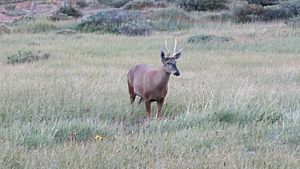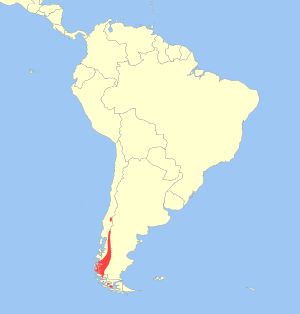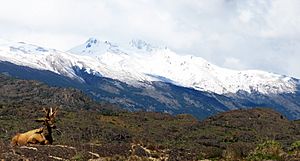South Andean deer facts for kids
Quick facts for kids South Andean deer |
|
|---|---|
 |
|
| Conservation status | |
| Scientific classification | |
| Genus: |
Hippocamelus
|
| Species: |
bisulcus
|
 |
|
| Geographic range | |
The South Andean deer (Hippocamelus bisulcus) is also known as the southern guemal or Chilean huemul. This deer is an endangered species. It lives in the mountains of Argentina and Chile.
The South Andean deer is one of two types of mid-sized deer in its group, called Hippocamelus. It lives in the high mountains and cold valleys of the Andes. Scientists study where these deer live, what they eat, and how they behave. There are not many left, and protecting them is very important.
The huemul is a special animal in Chile. It is part of the country's national coat of arms. Since 2006, it has been a National Natural Monument.
Contents
About the South Andean Deer

The South Andean deer has a strong body and short legs. This helps it move easily on rocky, difficult land. Its fur is brown to grey-brown. Its belly and throat are white. The long, curly hairs of its coat keep it warm and dry.
Female deer (does) weigh about 70 to 80 kilograms (154-176 pounds). They stand about 80 centimeters (31 inches) tall. Male deer (bucks) weigh around 90 kilograms (198 pounds) and are about 90 centimeters (35 inches) tall. Baby deer (fawns) are born without spots. Their size is similar for both males and females.
Only male deer have antlers. They lose their antlers each year in late winter. Males also have a black "face mask" that looks like a heart shape. This mask surrounds their brown forehead.
These deer often gather in mixed groups of males and females. The bigger the group, the longer they stay together. Larger groups are seen farther from rocky slopes. This might mean it's safer from predators in open areas.
Where the Huemul Lives

The South Andean deer lives in many different kinds of places. It often likes open areas with small bushes and rocks. It also lives in mountain forests and at the edges of forests. One study found that males and young deer liked grassy areas. Females were mostly found on rocky cliffs. Baby deer were only found on cliffs. A plant called Gunnera was a main food source.
In the past, these deer lived in many parts of southwestern South America. But now, their situation is very serious. In Argentina, there were only about 350 to 600 deer in 2005. These groups were spread out and separated. Experts have asked for more research to help save these deer.
Many things threaten the huemul. These include human activities and invasive species. Invasive species are plants or animals that are not native to an area and cause harm. For example, in Argentina, the red deer eats the same plants as the huemul. This forces the smaller huemul to live in less suitable areas. This makes them more likely to get sick or have fewer babies. The cougar is the only natural predator of the huemul. Cougar attacks are a main cause of death for huemul in Argentina.
Protecting the Huemul
The International Union for the Conservation of Nature (IUCN) says that the number of huemul has dropped by 99 percent. Their living areas have shrunk by more than 50 percent. Because of this, the species is listed as "Endangered" on the IUCN Red List. The main threats are their habitats being broken up and illegal hunting.
To help the huemul, Argentina and Chile signed an agreement. It is called the "Memorandum of Understanding (MoU) on the Conservation of the huemul". This agreement started on December 4, 2010. It helps the two countries work together to protect the deer. This is important because the deer often move across the border between Argentina and Chile.
Agreement to Protect the Huemul
 |
|
| Context | Nature conservation |
|---|---|
| Effective | 4 December 2010 |
| Signatories | |
| Languages | Spanish |
This agreement is a special plan between Argentina and Chile. It was made to protect the South Andean Huemul. The agreement started on December 4, 2010. It helps the two countries work closely together. This is because the huemul often moves between their border areas.
In 2010, there were fewer than 1500 huemul left in the wild. They lived in small, separate groups. Both countries knew they had to work together. They wanted to stop the species from disappearing. This agreement helps them fight illegal hunting. It also helps fix damaged habitats and stop diseases.
The agreement protects all huemul living in Argentina and Chile. The IUCN says the huemul is "Endangered." This means it is at high risk of dying out. The main dangers are their homes being broken up and illegal hunting.
How the Countries Work Together
Argentina and Chile agreed to work together to:
- Protect huemul populations that live in both countries.
- Find and protect the places where the huemul must live to survive.
- Find out what harms the huemul, like illegal hunting or habitat damage.
- Suggest ways to control these problems.
- Create a plan to protect the huemul together.
- Share information about the deer, like scientific facts and legal rules.
- Help park rangers and experts work together.
- Report on their progress each year.
- Hold meetings every year, switching between the two countries.
The agreement started right away on December 4, 2010. It lasts for three years and renews automatically.
Working on the Action Plan
Experts from both countries are creating a shared plan. This plan will help them exchange information. It will also help train staff and park rangers. They will work together on ways to protect the deer.
More research will help them understand the huemul better. They will also study why some groups of deer are not growing. They will collect more information on where the deer live and what threatens them. Educational activities will help people learn about the huemul's serious situation.
In September 2011, a workshop was held in Valdivia, Chile. Its goal was to create the first steps for the shared action plan.
Argentina has already started some actions. They are watching huemul in Los Alerces National Park. They are also updating a database of huemul sightings. They are helping with a study about the huemul's history in Chile. Argentina is also updating plans for national parks to include huemul protection. They are working on a project to control farm animals in huemul areas. They have also given talks and made posters to teach people about the huemul.
Chile is doing similar things. Park rangers are watching for illegal hunting. There are plans to bring huemul back to some areas. They are also working to reduce competition with farm animals. Chile is raising awareness and making rules stronger.
See also
 In Spanish: Huemul para niños
In Spanish: Huemul para niños


